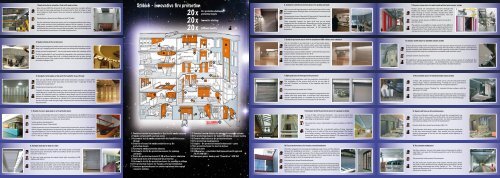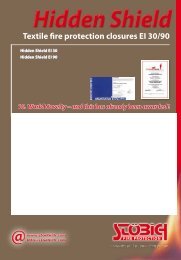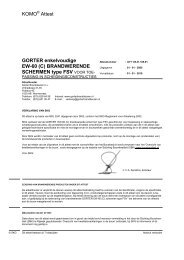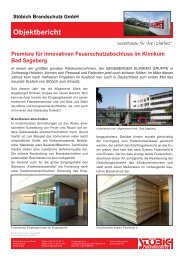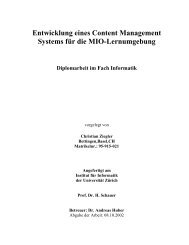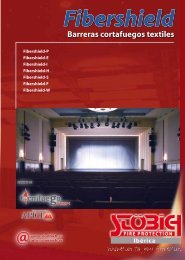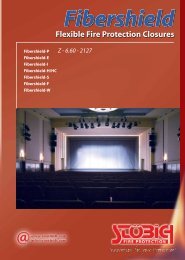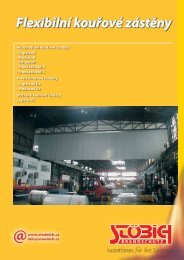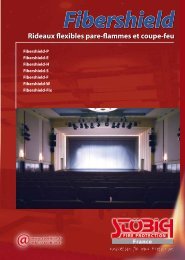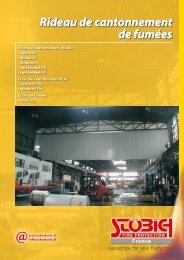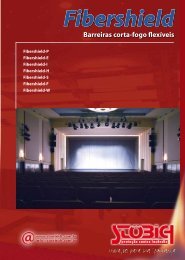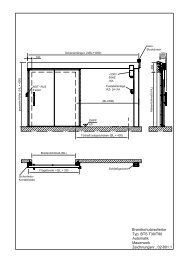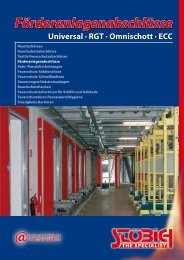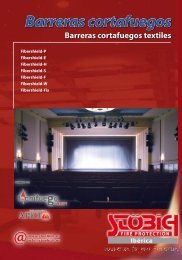Product range - Stöbich Brandschutz
Product range - Stöbich Brandschutz
Product range - Stöbich Brandschutz
Create successful ePaper yourself
Turn your PDF publications into a flip-book with our unique Google optimized e-Paper software.
1. Smoke extraction by automatic or fixed textile smoke curtains<br />
How can you fulfill the demands of safe smoke extraction concepts without<br />
the need to have large openings for exhaust and for fresh air intake or with<br />
cross streams in high rooms? How can rooms be optimizes for mechanical<br />
extraction?<br />
Smoke barriers Supercoil and Moducoil with CE-label.<br />
For the mechanical extraction rooms can be compartmentalized with roomhigh<br />
smoke curtains what significantly reduces the fan capacity. In case of<br />
emergency, automatic smoke curtains coil down to the corresponding level,<br />
indicated by the extraction concept. Well integrable in the interior design and<br />
for this awarded several times (“Invisible fire protection”).<br />
2. Smoke curtains with a curved course<br />
How can you integrate a smoke curtain in an architecturally attractive surrounding,<br />
e.g. a shopping malls and at the same time also provide a leakage of 0%?<br />
Smoke curtain Smokeshield-C – the curved smoke curtain with a leakage of 0%<br />
DurThe Smokeshield-C can be perfectly integrated in the architecture because<br />
of it different shapes like circle- or ellipse shape but also as open curved<br />
(serpentine) system. The smoke curtain is hidden in the suspended ceiling and<br />
provides a leakage of 0%.<br />
3. Automatic textile smoke curtain with the feasibility to pass through<br />
How can you fulfil the demand of safe smoke extraction concepts in areas where<br />
smoke barriers close all the way down to the floor level - especially if there are<br />
requests for escape doors?<br />
Smoke barrier Stripecoil with CE-label.<br />
Creation of smoke compartments in escape routes respectively in areas where the<br />
smoke barrier is closed down to the floor level and persons have to pass through the<br />
system. The Stripecoil system is available in drop length up to 3,5m with a twin coil<br />
system for unlimited widths. The frequency of persons passing through the smoke<br />
barrier is at approx. 200/minute at a width of 3m. Due to the little demand of space<br />
for the casing, the walk through height (headroom) has minimal limitations (invisible<br />
fire protection)<br />
4. Creation of areas to guide smoke or as fire protection closure<br />
How can the existing high demands on tightness of smoke barriers be fulfilled? Or how can<br />
a fire protection closure for a room in prestigious buildings be adjusted to the architecture?<br />
No limitation by side guides or pillars can be accepted.<br />
Smoke guiding: Smokeshield-S<br />
Fire protection closure: Fibershield-S<br />
Smoke protection closure Smokeshield-S respectively fire protection closure: Fibershield-S<br />
offer a polygon shaped design. No disturbing side guides are necessary to achieve the<br />
requested tightness. Due to the flat design, the systems can be perfectly be integrated into<br />
ceilings and are available in extremely large widths and lengths where the angle may vary<br />
from +/- 90° (30° -150°).<br />
5. Automatic smoke barrier made of a fabric<br />
How you can make sure that the smoke will not be spread out through<br />
large openings by the elevator shaft from one floor to the next or from<br />
one room to the next ?<br />
Or how can large openings be sealed smoke tight according to DIN<br />
18095 or EN1634-3 ?<br />
Secure, large scale smoke closures, even at high pressure loads (50 pa)<br />
and temperatures up to 200°C. Due to the small architectural design,<br />
highest demands are covered („Invisible fire protection“). Optionally<br />
smoke protection closures can be designed as fire protection closures.<br />
<strong>Stöbich</strong> - innovative fire protection<br />
20 x<br />
20 x<br />
20 x<br />
6<br />
6<br />
18<br />
4 5<br />
1. Smoke extraction by automatic or fixed textile smoke curtains<br />
2. Smoke curtains with a curved course<br />
3. Automatic textile smoke curtain with the feasibility to pass<br />
through<br />
4. Creation of areas for smoke conduction or as fire<br />
protection closure<br />
5. Automatic smoke protection closures<br />
6. Automatic textile fire protection closures for openings<br />
and walls<br />
7. Textile fire protection closures EI 90 without water admission<br />
8. High speed doors with integrated fire protection<br />
9. Automatic textile fire protection closure for openings in ceilings<br />
10. Fire protection closures for facades, external installation<br />
11. Conveyor system closures for uninterrupted and interrupted<br />
conveyor systems<br />
1<br />
2<br />
1<br />
5<br />
18<br />
9<br />
17<br />
8<br />
14<br />
7<br />
11<br />
20<br />
13<br />
11<br />
18<br />
Fire protection challenges /<br />
protection targets<br />
Innovative solutions<br />
Customer benefits<br />
19<br />
15<br />
5<br />
6<br />
18<br />
12<br />
12<br />
16<br />
12. Conveyor system closures for pneumatic conveyor systems<br />
13. Fire protection closures for industrial kitchen exhaust system<br />
14. Elevator shaft doors as fire protection closure<br />
15. Fire protection stacking doors<br />
16. Isogate – fire protection insulation doors and – gates<br />
17. Fire protection hoods for electric devices<br />
18. Control units<br />
19. CANopen bus – cross linked hold open units with approval<br />
Z-6.5-1990/2011<br />
20. Emergency power back up unit “Powerdrive” 400 VAC<br />
c<br />
10<br />
3<br />
6. Automatic textile fire protection closures for openings and walls<br />
How can you seal large openings in walls and ceilings which create<br />
fire compartments although there is limited space or architectural<br />
demands?<br />
Fire protection closure Fibershield-P, Fibershield-E, Fibershield-I and<br />
Fibershield-W, tested according to DIN EN1634-1.<br />
These automatic systems are quite small and can be easily<br />
integrated into the architecture. Depending on the fire protection<br />
classifications you can choose between “E90 – 180”, “EW60 – 90”<br />
or “EI 30 – EI 60 without water, with water - EI 120” (invisible fire<br />
protection)<br />
7. Textile fire protection closure with the classification EI90 without water admission<br />
How is it possible to seal openings in an architecturally appealing<br />
environment with fire curtains which need heat insulating<br />
characteristics with the classification El 90 (T 90) while affecting<br />
the architecture as less as possible?<br />
Fire protection closure “Hidden Shield” – the textile fire protection<br />
closure with the classification El 30 / El 90<br />
This closure that meets highest architectural demands and open<br />
design concepts, is the first fire protection closure in the world without<br />
side guides. Due to the special and structural construction<br />
there are no further compensatory actions, such as sprinklers, necessary<br />
to reach the textile closures’ protection target.<br />
8. High speed doors with integrated fire protection<br />
Is there a high speed door with fire protection characteristics?<br />
The installation of the system shall only be on one side of<br />
the wall. Therefore no limitation of the opposite wall side is<br />
necessary.<br />
Fire protection high speed door Firefast<br />
A fire protection closure which is completely integrated into the<br />
robust spiral high speed door or interlayer high speed doors<br />
(3m/sec. opening speed). It is installed only on one side of the<br />
wall and only one control unit is necessary for all functions.<br />
9. Automatic textile fire protection closure for openings in ceilings<br />
In case of high architectural demands - how can you assure that<br />
openings in ceilings, which create fire compartments, can be sealed<br />
according to the protection target?<br />
Fire protection closure Fibershield-H tested according to DIN EN<br />
1634-1<br />
These systems allow for a horizontal sealing of large openings<br />
in ceilings up to a width of 20m and of great lengths. The Duplex<br />
drive system assures a safe closing process. The drive unit makes<br />
ensure safe closing. The protection targets E 120 respectively EI 120<br />
(insulation with sprinkler) can be achieved.<br />
10. Fire protection closures for facades, external installation<br />
If two fire compartments converge at a buildings inside corner, or if the distance<br />
between the buildings is less than 3 – 5 meters or the roof of an extension is<br />
connected to a wall with openings it has to be assured that the fire does not<br />
spread through the openings in the façade. Which opportunities are there<br />
without having to close the openings with masonry?<br />
Fire protection closure Fibershield façade<br />
This protection can be ensured by the installation inside and outside the building.<br />
By installations inside or outside of the building this protection can be guaranteed.<br />
With these automatic sealing systems standard windows without fireproof<br />
glazing can be used. These standard windows are operable and therefore do<br />
not restrict the room-comfort.<br />
11. Conveyor system closure for uninterrupted and interrupted conveyor systems<br />
Various goods are transported criss-cross through the<br />
building by various conveyor systems like roller-, belt-,<br />
chain carrying or circular conveyors. Thereby they often<br />
break through fire protection compartments. How can<br />
these openings be sealed in case of a fire?<br />
Conveyor system closures of different series Universal-B,<br />
RGT, OS, ECClos<br />
The systems are available in a large variety for the different<br />
types of conveyor techniques and are approved by the building<br />
authorities. These sealing systems don’t affect the conveying<br />
process even with uninterrupted conveyor systems.<br />
12. Conveyor system closure for pneumatic conveyor systems<br />
It has to be assured that no fire is transferred in case that pipes where materials are conveyed with an<br />
air stream (over or under pressure) and pass through fire rated walls or ceilings. There is a danger that<br />
the thin, unstable pipes deform and therefore create openings in the walls or ceilings. Since standard<br />
fitting fire protection claps for ventilation are unsuitable what should be used?<br />
Conveyor system closure Ecotube<br />
The operation is always guaranteed as the cross section of the conveyor system is not affected. The<br />
systems – even for large cross sections – can be designed for over or under pressure operation. The<br />
conveyor system closures are applicable for dusty, lamellar, sliceable materials.<br />
13. Fire protection closures for industrial kitchen exhaust systems<br />
Is there a fire protection closure, which can be used for industrial kitchen<br />
exhaust ducts, when a standard fitting - fire flap can not be used due to<br />
negative effects on the functionality of fat and grease deposits?<br />
Fire protection closure “Duoflap” for industrial kitchen exhaust with the<br />
approval Z-41.3-668<br />
Safe and quick closing even with fat and grease deposits in the exhaust duct.<br />
Applicable in walls and ceilings where little space beside the duct is needed.<br />
These systems are easy to maintain because there are no functional gaps<br />
14. Elevator shaft doors as fire protection closure<br />
In the case of elevator shafts running through fire compartments e.g.<br />
ceilings, it has to be assured that the fire does not spread through the<br />
elevator shaft to another fire compartment. Are doors available which<br />
are tested according to the norm EI 30 classification?<br />
Elevator shaft doors tested according to EN 81-58<br />
Tested elevator shaft doors can be installed inside elevator shafts due<br />
to the low constructional depth. They provide not only resistance<br />
against the passage of fire but also the required smoke tightness in<br />
case of a fire load.<br />
15. Fire protection stacking doors<br />
Are there solutions, to have a fire rated closing of openings in walls, in<br />
case there is no space for the parking position e.g. for fire protection<br />
sliding doors?<br />
Fire protection stacking door Omnicompact<br />
The fire protection stacking door only requires minimal space above<br />
the lintel, as each element can be stacked above the lintel or can be<br />
pulled along underneath the ceiling. Design in T 30 – T 90 up to a<br />
maximum dimension of 9 x 6 m is possible and the systems can also be<br />
delivered in stainless steel.
16. Isogate - Fire protection insulation doors and –gates<br />
Openings in fire rated walls of cold storage rooms (+4°C) or deep<br />
freeze rooms (-28°C) not only need fire protection sealing, but also<br />
insulation. This can be done with 2 doors (insulation door - fire<br />
protection door) or does there exist more efficient solutions ?<br />
Revolving- and sliding doors of the Isogate series.<br />
Proven for more than 15 years, these systems provide a reliable<br />
insulation, which is to say that there is no condensation water or<br />
icing when these systems are in operation. In case of a fire a safe<br />
fire protection sealing is guaranteed – this is tested according to<br />
EN 1634-1. Even uninterrupted conveyor systems in cold storage<br />
rooms can be sealed<br />
17. Fire protection hoods for electric devices<br />
When there are photocopiers, printers or other electrical equipments with a<br />
fire load in necessary corridors in the building, it has to be ensured that the fire<br />
does not affect the escape. How can the protection be ensured<br />
without restriction of the operating procedure?<br />
Fire protection hood copy cap<br />
Tested fire protection hoods, automatically unfold from picture frames or<br />
ceilings and enclose the object which is to be protected. The fire is smothered<br />
and the smoke is captured underneath the hood. These hoods<br />
can even protect high-quality equipment against forge water (e.g. by<br />
activated sprinklers).<br />
18. Control units<br />
Are there optimised control units with a certificate of usability with<br />
fire protection doors, which are in their open position during daily<br />
operation but have to close in case of fire? Or for conveyor system<br />
closures whose safe closing shall not be hindered by conveyed<br />
materials or for complex systems?<br />
Various choices of control units from RZ 8 type for elementary<br />
requirements RZ 3/4 up to RZ 7 BMZ<br />
Depending on customers request from simple control units to buscontrol<br />
units, where a control via the operator-panel is possible and<br />
can easily be extended. Therefore comfort and safety are increased<br />
and the installation becomes easier.<br />
19. CANopen-Bus cross linked hold open device with approval Z-6.5-1990/2011<br />
Are cross linked control units (hold open units) with a certificate of usability for<br />
smoke doors, fire protection doors, conveyor system closures, etc. available?<br />
They need to communicate with bus control units, have to protect complex<br />
units and need to be handled easily.<br />
Bus control unit RZ-7 MBZ 2 with or without RZ 7-FAA<br />
The bus control unit for <strong>Stöbich</strong> products as well as for all further brands of<br />
smoke and fire protection closures. Using the operator panel, all systems can<br />
be controlled and easily be extended. This increases the safety as well as the<br />
comfort and reduces the effort for installation.<br />
20. Emergency power back up unit “Powerdrive“ 400VAC<br />
The closing area has to be free due to the demand that even in case of loss of<br />
primary power supply (mains supply) the conveyor system closure has to close<br />
safely. What does an efficient solution look alike?<br />
Emergency power supply system Powerdrive, which guarantees a continuing<br />
power supply to conveyor drive systems.<br />
This local power supply units with a capacity of 5 kW can be installed directly<br />
on site, directly near the driving motors of the conveyor technic and offer a high<br />
safety as well as a low space requirement and a low effort in installation and<br />
maintenance. 2,4 or 6 driving motors can be relieved for each unit.<br />
<strong>Stöbich</strong> – Fire Protection<br />
Since 1980 <strong>Stöbich</strong> <strong>Brandschutz</strong> has become the<br />
global market leader for conveyor system closures<br />
as well as an international trendsetter in the field of<br />
textile fire and smoke protection.<br />
The know-how, which grew by the impressive<br />
number of completed projects and fire tests as<br />
well as by the proven constructive competence,<br />
made <strong>Stöbich</strong> the fire protection specialist with a<br />
wide <strong>range</strong> of products and an extensive <strong>range</strong> of<br />
services.<br />
Ten world novelties and five awards so far, express<br />
the innovative and customer orientated design of<br />
the <strong>Stöbich</strong> products and an effective control of all<br />
the processes.<br />
Four branch offices and numerous national and<br />
international agencies allow for the direct presence<br />
and proximity to our customers during all phases of<br />
the project.<br />
Awards „Invisible fire protection“<br />
„Bauen im Bestand“<br />
from the Federal<br />
Ministry<br />
Headquarter<br />
<strong>Stöbich</strong> <strong>Brandschutz</strong> GmbH<br />
Pracherstieg 6<br />
38644 Goslar, Germany<br />
Phone +49-(0)5321-5708-0<br />
Fax +49-(0)5321-5708-1991<br />
Branch South<br />
<strong>Stöbich</strong> <strong>Brandschutz</strong> GmbH<br />
Gewerbehof 8<br />
73441 Bopfingen, Germany<br />
Phone +49-(0)7362-9614-0<br />
Fax +49-(0)7362-9614-50<br />
MDR 1 award for<br />
the TV series<br />
„simply genious“<br />
Branch East<br />
<strong>Stöbich</strong> <strong>Brandschutz</strong> GmbH<br />
Geltestraße 12<br />
06188 Landsberg OT Queis, Germany<br />
Phone +49-(0)34602-552-0<br />
Fax +49-(0)34602-552-50<br />
Branch West<br />
<strong>Stöbich</strong> <strong>Brandschutz</strong> GmbH<br />
Max-Planck-Straße 13<br />
59423 Unna, Germany<br />
Phone +49-(0)2303-98689-0<br />
Fax +49-(0)2303-98689-50<br />
Certificate mips<br />
April 2005, Moskau<br />
Lower Saxon Foreign<br />
Trade Award 2010<br />
International sales partners respectively subsidiaries<br />
· Australia<br />
· Austria<br />
· Belgium<br />
· Bosnia and<br />
Herzegovina<br />
· Bahrain<br />
· Bulgaria<br />
· Brazil<br />
· Canada<br />
· China<br />
· Croatia<br />
· Cyprus<br />
· Czech<br />
· Denmark<br />
Headquarter<br />
Branch South<br />
Branch East<br />
Branch West<br />
· Estonia<br />
· Finland<br />
· France<br />
· Great Britain<br />
· Greece<br />
· Hong Kong<br />
· Hungary<br />
· Iceland<br />
· Ireland<br />
· Israel<br />
· Italy<br />
· Latvia<br />
· Liechtenstein<br />
· Lithuania<br />
· Luxembourg<br />
· Macedonia<br />
· Mexico<br />
· Netherlands<br />
· New Zealand<br />
· Norway<br />
· Poland<br />
· Portugal<br />
· Qatar<br />
· Romania<br />
· Russia<br />
· Serbia and<br />
Montenegro<br />
· Saudi Arabia<br />
German Award of Innovation<br />
Architecture and construction<br />
· Singapore<br />
· Slovakia<br />
· Slovenia<br />
· Spain<br />
· Sweden<br />
· Switzerland<br />
· Turkey<br />
· Ukraine<br />
· USA<br />
· United Arab Emirates<br />
06/2011-03-K-2000-DE<br />
<strong>Product</strong> <strong>range</strong><br />
Conversion chart for building material classifications according to<br />
DIN EN 13501-1 for the <strong>Stöbich</strong> product <strong>range</strong><br />
Conversion chart for building material classifications according to DIN EN 13501-1<br />
Requirements from construction<br />
supervision<br />
Non-combustible/<br />
non flammable<br />
German standard European classification<br />
Building material classification<br />
according to DIN 4102<br />
A<br />
A1<br />
A2<br />
Additional requirements European classification according to DIN EN 13501-1<br />
No smoke Building products, except linear tube insulation material<br />
X A1<br />
X A2 – s1,d0<br />
Combustible/flammable B<br />
X B – s1,d0; C – s1,d0<br />
Low flammability B1<br />
X<br />
A2 – s2,d0: A2 – s3, d0: B– s2, d0; B – s3, d0; C – s2,d0: C – s3, d0<br />
A2 – s1,d1; A2 – s1, d2; B – s1,d1; B – s1,d2; C – s1,d1 C – s1,d2<br />
A2 – s3, d2; B – s3,d2; C – s3,d2<br />
Normal flammability B2<br />
D – s1,d0; D– s2, d0; D – s3,d0; E<br />
D – s1,d1; D – s2,d1; D – s3,d1; D – s1,d2;; D – s2,d2; D – s3,d2; E – d2<br />
Easily inflammable B3 F<br />
Derivation of the short cuts Criterion Range of application<br />
S (Smoke) Smoke emission Requirements on the smoke emission<br />
D (Droplets) Dripping of burning parts Requirements on the burning parts which drip off<br />
Conversion chart for fire resistance classifications for special building components according to DIN EN 13501-2<br />
Requirements from construction<br />
supervision<br />
Fire-retardand<br />
Fire-retardand and made of non<br />
combustible building materials<br />
Highly fire-retardand<br />
Fire proof<br />
Fire proof and made of non<br />
combustible building materials<br />
German standard European classification<br />
Short cut<br />
Special building component<br />
Classification according to DIN<br />
4102-2<br />
according<br />
to DIN<br />
4102-2<br />
Fire protection closures (also for<br />
conveyor systems)<br />
Without smoke With smoke<br />
protection protection<br />
Smoke<br />
protection<br />
doors<br />
Cable ducts Pipe sealings<br />
Fire-protective<br />
glazing<br />
Fire resistance classification<br />
„F30“<br />
F 30 – B EI 30-C… 2 EI 30 EI 30-U/U E30 E30<br />
Fire resistance classification<br />
„F30“ and made of non<br />
combustible building materials<br />
Fire resistance classification<br />
„F60“ and considerably made<br />
of non combustible building<br />
materials<br />
Fire resistance classification<br />
„F60“ and made of non<br />
combustible building materials<br />
Fire resistance classification<br />
„F90“ and made of non<br />
combustible building materials<br />
Fire resistance classification<br />
„F90“ and made of non<br />
combustible building materials<br />
F 30 – A<br />
F 60 – AB<br />
Comments to the European architectural drawings<br />
Classification for smoke barriers according to DIN EN 13501-4<br />
EI 2 60-C… EI 60<br />
EI60-U/U<br />
F 60 – A EI 60-C/U<br />
F 90 – AB EI 2 90-C… EI 90<br />
E 90 – A<br />
Fire resistance 120 minutes - EI 120<br />
Smoke tight and self closing S m -C…<br />
Derivation of the short cuts Criterion Range of application<br />
R (Resistance) Bearing capacity<br />
E (Integrity) Integrity<br />
I (Insulation) Heat insulation under fire load<br />
W (Radiation)<br />
(originally coming from „Watt“)<br />
Benefits<br />
Limitation of the radiation<br />
To describe the fire resistance<br />
capability<br />
EI 90-U/U<br />
EI 90-C/U<br />
EI 120-U/U<br />
EI 120-C/U<br />
Lift doors in combination<br />
with fire resistant lift walls<br />
E 60 E 60<br />
E 90 E90<br />
Derivation of the short cuts Criterion Range of application<br />
S m (Smoke max. leakage rate )<br />
C… (Closing)<br />
P (originally coming from<br />
„Power“)<br />
All smoke barriers have to prevent the passage of smoke. Thereby the specimen has to keep its dimensional stability without<br />
a) create gaps or openings in dimensions larger than stated in EN 12101-1<br />
b) creating flames in an ongoing manner (additionally no parts are allowed to drop from the specimen during the first 600 seconds)<br />
c) to break down<br />
D – Duration of dimensional stability at 600°C<br />
DH – Duration of dimensional stability at higher temperatures (ISO curve)<br />
Classes<br />
D600 30 60 90 120 A<br />
DH 30 60 90 120 A<br />
l1, l2<br />
„A“ is the time above 120 minutes<br />
Limitation of the smoke permeability<br />
(tightness, leakage), it fulfils the<br />
requirements of both ambient<br />
temperatures as well as at 200°C.<br />
Self closing characteristics including<br />
cycle test<br />
To maintain the power supply and/or<br />
transmission of the signal<br />
Different criterias for the thermal<br />
insulation<br />
Smoke protection door, ventilation<br />
systems including hatches<br />
Smoke protection doors, fire<br />
protection closures (including<br />
conveyor systems)<br />
Electrical cable systems in general<br />
Fire protection closures (including<br />
closures for conveyor systems)


